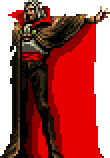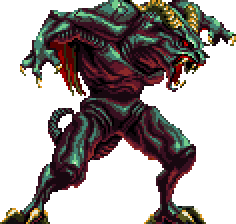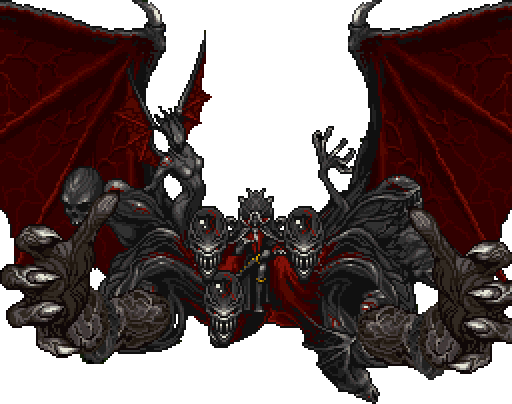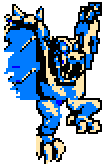| . |
Castlevania:
Harmony of Despair
|
. |
Harmony of
Despair is at its core an amalgamation of
the 2D adventure-RPG titles dating back to Symphony of the Night. In
honor of the winning formula it patented way back in 1997--a style of gameplay
which still endures to this day--the developers naturally chose for its final
boss to be the Symphony version (the Rondo variant encountered
in the opening "Final Stage"). The ol' boy sticks firmly to his
teleporting scheme, whereby he stops to release, at random, 5-directional
fireballs or those pulsating, fiery spheres that are released high and low
in alteration. Though, like Despair's very theme, there are a few new
twists; mainly, he can command six flame-pillars to rise up from random locations,
with a fair amount of warning, or six flame-pillars spread at parallel length
and executed during his sphere-releasing phase. When "playtime is over,"
Dracula will transform.
 |
|
|
 |
This familiar brute retains its penchant
for overwhelming heroes using its long jumps and large frame, but it, too,
has a few new tricks up its sleeve. Its most derivative attacks are (a) its
single exhaled fireballs, which hit the ground, form into a small flame pillar,
then wave forward along the ground; and (b) its high jumps, during which it
drips down a storm of acidic liquid, any drop capable of inflicting a poison
status. Since the creature is less active then you'll remember, often leaving
itself wide open to large amounts of abuse, you may be lulled to sleep and
fall victim to its laser attack, during which it dives backwards and fires
down, diagonally, an exceptionally large, devastating beam. Pound on it long
enough and you'll reveal Dracula's darkest form.
 |
|
|
 |
Dracula's final form is actually his
Symphony of the Night final form (as encountered post-Shaft) upgraded
considerably. Now, you'll know from experience that Dracula will take swipes
at you with his large claws, which will otherwise hurt you via simple contact,
but you may not be prepared for his new array of attacks. There's no particular
order to them: The three active heads will spit down a fireball that will
immediately split in two and wave in either direction. He'll fire out seven
triangle-shaped projectiles, the glowing charges tossed directly toward the
scattering heroes. He'll command flame pillars to rise up in random locations,
each blaze capable of limited movement; as could his first form could, he
can also command seven parallel flames, spread across the entire room. He'll
summon a demonic force that gathers into the screen's center then quickly
expands outward in all directions, engulfing the entire room except for its
very edges and killing exposed heroes in one shot. Using "Dark Meggido,"
he'll command at either of the room's sides three flame pillars, all of which
can also instantly kill. He'll conjure a circle of bladed, heart-shaped projectiles,
then fire them out in all directions; as a side effect, the attack will "charm"
one of the heroes, who will then assault his or her allies. Similarly, he'll
channel rage and fire out beams in all directions. Finally, he can render
himself temporarily invulnerable, able to guard himself against attacks. As
it was before, only the three vampiric heads can take damage.
 |
|
|
 |
Despair's
10th DLC chapter, a retro-themed stage that replicates the look and feel of
original Castlevania experience, features the appropriate 8-bit enemies
and a "surprise" final boss: Count Dracula as we remember him from
the NES classic. The old boy has pumped up a bit and has some new tricks,
like his new fireball attack, using which he unleashes three 3 sets of 8 fireballs
arcing speedily in three directions--downward, eye-level, and back toward
the ceiling--and spreading farther out as they travel across the room (he
now has up to six enemy combatants to deal with, after all). Too, Dracula
can both teleport and dash his way out of danger. His energy depleted,
Drac'll transform into the familiar blue beast, who'll start the proceedings
by spewing three separate fireball streams--the trio of flames rotating around
the beast and progressively stretching farther out and with increasing arc.
It has two modes of travel: High jumps of variable distance and a long, swooping
dash attack executed with much quickness. Quite simply: This version of Dracula,
in either form, is far more versatile than its original incarnation.






